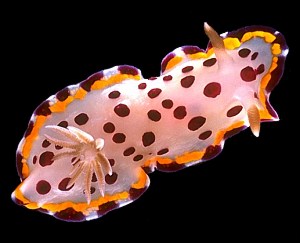
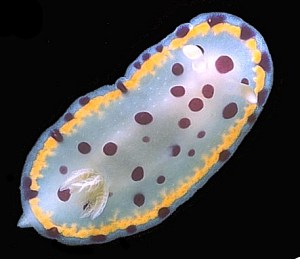
Chromodoris tumulifera
Collingwood, 1881.
Order: NUDIBRANCHIA
Suborder: DORIDINA
Family: Chromodorididae
DISTRIBUTION
Tropical Western Pacific.
PHOTO
UPPER: Hinchinbrook Is, North Queensland, October 1983.
LOWER: Juvenile showing mantle glands around inside edge of yellow border. Darwin, Northern Territory, June 1987
PHOTOS: Bill Rudman.
I previously thought that C. tumulifera and C. bimaensis were distinct species, mainly on the grounds that the spots of C. bimaensis are distinctly purple, (red in C. tumulifera ), and are often open in the centre to form irregular rings (Rudman, 1983). However further specimens I have seen from Australia and New Caledonia of red spotted specimens show a range of colour patterns; some specimens having spots outside the submarginal orange border and others not; some specimens with solid red spots and others with a mixture of spots and irregular rings as in `typical' C. bimaensis. The only difference then is the purple versus red coloration. As they show a range from a very light to a very dark red, it would seem better to consider C. tumulifera and C. bimaensis as one species.
In juvenile animals branches of the dendritic mantle glands are clearly visible along the inside edge of the submarginal yellow border. As the animals grow larger the mantle becomes more opaque white and the glands are obscured. A close-up picture of the glands can be seen in an answer on the Defensive Glands page.
Note added 12 Feb, 2002: Gosliner (1994) described C. kitae from northern Madagascar as a new species, mainly because the orange submarginal line was interrupted by both white and red-purple spots, while in C. tumulifera it is only interrupted by purple spots. Another difference is that in C. kitae there are white spots on the gills and rhinophores. I suspect the differences fall within the range of variation of C. tumulifera.
References:
• Gosliner, T.M. (1994) New species of Chromodoris and Noumea (Nudibranchia: Chromodorididae) from the western Indian Ocean and southern Africa. Proceedings of the California Academy of Sciences 48(12): 239-252. (8 figs)
• Rudman, W.B. (1983a) The Chromodorididae (Opisthobranchia: Mollusca) of the Indo-West Pacific: Chromodoris splendida, C. aspersa and Hypselodoris placida colour groups. Zoological Journal of the Linnean Society, 78: 105-173.
• Rudman, W.B. (1991) Purpose in Pattern: the evolution of colour in chromodorid nudibranchs. Journal of Molluscan Studies, 57, (T.E. Thompson Memorial Issue): 5-21.
Rudman, W.B., 1999 (May 21) Chromodoris tumulifera Collingwood, 1881.. [In] Sea Slug Forum. Australian Museum, Sydney. Available from http://www.seaslugforum.net/find/chrotumu
Related messages
Chromodoris tumulifera from northern Gulf of Thailand
April 22, 2010
From: Vie Panyarachun
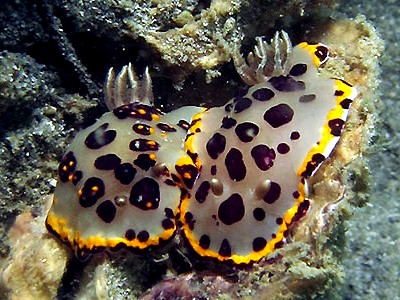
Dear Dr. Rudman,
A friend of a friend spotted these chromodorids recently. Are they Chromodoris tumulifera? I have never seen these in my area (northern Gulf of Thailand) before and thought that it might be of interest.
Locality: Man Nai Island [Ko Man Nai], 5 metres, Rayong, Thailand, Gulf of Thailand, 10 April 2010, muddy, under pier. Photographer: Thirachat Chandrangarm.
Thank you.
Vie
vpanyarachun@hotmail.com
Thanks Vie,
It is always good to get records from your part of the world. Yes this is C. tumulifera. If your frined has higher resolution photos which show the sponge they are apparently feeding on I would be interested in seeing them
Best wishes,
Bill Rudman
Chromodoris tumulifera from Singapore
February 25, 2005
From: Lim han Peng
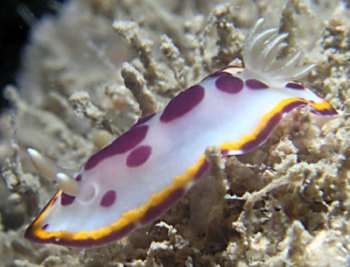
Hi,
I need your help to ID this nudibranch. Couldn't be sure if its Chromodoris splendida or Chromodoris daphne.
Locality: Pulau Hantu, Singapore, South China Sea. Depth: 12 m. Length: 30 mm. 19 February 2005. low Vis. Photographer: H.P.Lim
Thanks
hp
limhp@hotpop.com
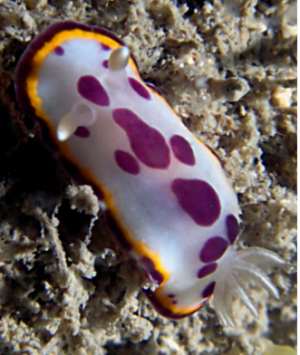
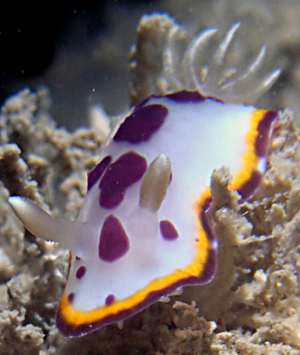
Dear hp,
This ceratinly looks like the two species you mentioned but both of those e species are only found in southeastern Australia, where there is a large group of red-spotted species mimicking each other [see red-spotted chromodorids Fact Sheet]. This is Chromodoris tumulifera which was described from the South China Sea in 1881.
Best wishes,
Bill Rudman
Chromodoris woodwardae & C. tumulifera
March 7, 2003
From: Nishina Masayoshi
Dear Bill,
I have noticed that the animal in the lower right photo on the Chromodoris woodwardae Fact Sheet and my photo of Chromodoris tumulifera from Echizen look very similar. What are the key differences between Chromodoris woodwardae Rudman, 1983 and Chromodoris tumulifera Collingwood, 1881? I wonder if C. tumulifera and C. woodwardae are the same?
Best Regards,
Nishina Masayoshi
nishina@wips.co.jp
Masayoshi, N., 2003 (Mar 7) Chromodoris woodwardae & C. tumulifera. [Message in] Sea Slug Forum. Australian Museum, Sydney. Available from http://www.seaslugforum.net/find/9210Dear Nishina,
The white colour form of C. woodwardae does have some similarities to C. tumulifera but I guess the most obvious difference is that in C. tumulifera the yellow mantle border is submarginal and usually a series of short lines, while in C. woodwardae it is a continuous yellow band right at the edge. Also the red spots in C. woodwardae usually are ringed with a white band, slightly different in colour to the background white of the mantle.
Anatomically they have major differences, most noticeably in the radula, and C. tumulifera grows to a much larger size. Also C. woodwardae is endemic to southeastern Australia while C. tumulifera is a widespread tropical Indo-West Pacific species. These are two of a large group of red-spotted species which can be distinguished from each other by a combination of anatomical and colour features.
Best wishes,
Bill Rudman
Chromodoris tumulifera from Japan
September 12, 2002
From: Nishina Masayoshi
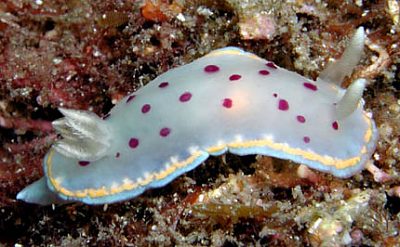
Dear Bill,
My wife Chikako found this animal. I tried to find information in other Japanese
sea slug site but I can find only a little. Most of them were mixed up with C. orientalis. So C. tumulifera should be considered to be very rare in Japan.
Date: 16 Aug. 2002
Loc: Echizen coast, Fukui prif. Japan
Lengh: 20mm
Depth: 4m
Water temp: 28C degree
Photo C. Nishina
Best Regards,
Nishina Masayoshi
nishina@wips.co.jp
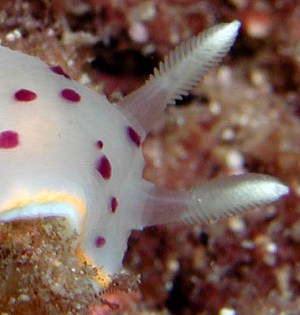
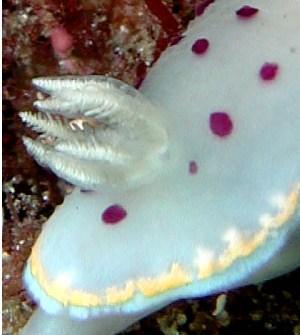
Thanks Nishina,
It's nice to get some photos from the northern part of its range,
Bill Rudman
Chromodoris tumulifera from New Caledonia
February 15, 2002
From: Bill Rudman
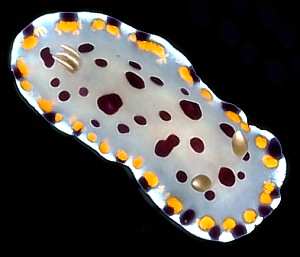
Here is an interesting photo to add to the C. tumulifera - kitae discussion. It is an animal I would identify as C. tumulifera from New Caledonia with a broken orange band, very similar to that described for C. kitae. It does not have white spots on the gills and rhinophores as reported for C. kitae.
PHOTO: Koumac Beach (=Baie de Ouanap), near Koumac, New Caledonia, 20°34'S, 164°16'E, mixed soft and hard substrate, grassbeds, algae, 23 October 1993, 3 specimens (12, 14 & 18mm long alive), AM C200600. Photo: Bill Rudman
Other records I have from New Caledonia are:
• Pointe de Pandop, near Koumac, New Caledonia, 20°35'S, 164°15.5'E, intertidal, hard substrate, algae, 2 October 1993, 29mm long alive, AM C200310.
• Koumac Beach (=Baie de Ouanap), near Koumac, New Caledonia, 20°34'S, 164°16'E, mixed soft and hard substrate, grassbeds, algae, 22 October 1993, 3 specimens (16, 18 & 18mm long alive), AM C200581.
Best wishes,
Bill Rudman
Chromodoris 'bimaensis' from Fiji
February 15, 2002
From: Bill Rudman
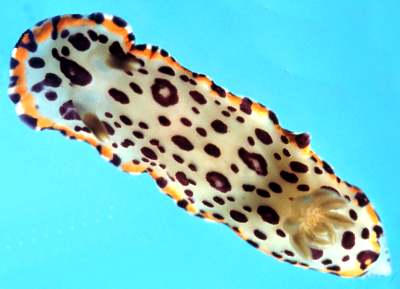
Here is a photo of an animal from Fiji which I initially identified as C. bimaensis Bergh, 1905 (Rudman, 1983). The many small purple spots and some rings are very similar to Bergh's illustration of that species. I now consider it to be a colour variation of Chromodoris tumulifera
Data: Lauthala Bay, Suva, Fiji, 14 May 1972. AM C131650. Photo: Bruce Carlson
• Rudman, W.B. (1983) The Chromodorididae (Opisthobranchia: Mollusca) of the Indo-West Pacific: Chromodoris splendida, C. aspersa and Hypselodoris placida colour groups. Zoological Journal of the Linnean Society, 78: 105-173.
Best wishes,
Bill Rudman
Chromodoris tumulifera from Hong Kong
January 27, 2002
From: Bill Rudman & Brian Darvell
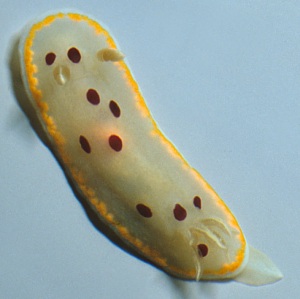
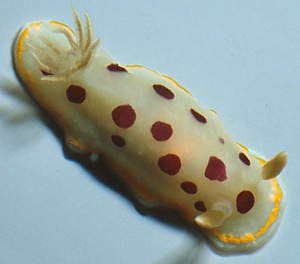
Here is some information and photos on Chromodoris tumulifera from Brian Darvell's Hong Kong collections.
White mantle with a bright golden orange submarginal band usually with irregular projections on the inside of the band.
There are large dark red or reddish-purple spots on the mantle, usually inside the yellow border but sometimes there are a few right on the mantle edge. The gills and rhinophores are a paie yellowish-brown. It grows to at least 25 mm long.
PHOTO:
AM C140168, 2 specimens, 24 July 1983, Site 11.87, South Ninepin (SE), 12 m, Hong Kong. Photos: Brian Darvell.
Hong Kong Collection Records:
AM C133725, 23 March 1982, Site 7.25, Hoi Sing Wan Tolo Harbour, intertidal. AM C137056, 2 specimens, 26 September 1982, Site 8.33, Wang Chau (W), 7 m. AM C137057, 10 October 1982, Site 1.34, Tsing Chau, Crooked Harbour, 8 m. AM C140158, 3 July 1983, Site 8.84, Tai Long Wan, centre reef, 9 m. AM C140168, 2 specimens, 24 July 1983, Site 11.87, South Ninepin (SE), 12 m. AM C142946, 2 specimens, 22 July 1984, Site 2.67, Kai Kung Tau, Kat 0 Chau, Mirs Bay, ~ 9 m. AM C150247, 15 April 1986, Site 3.80, Ping Chau (S), Mirs Bay, 2 m. Depth range: 0-15 m.
Reference:
• Rudman, W.B. & Darvell, B.W. (1990) Opisthobranch molluscs of Hong Kong. Part 1. Goniodorididae, Onchidorididae, Triophidae, Gymnodorididae, Chromodorididae, (Nudibranchia). Asian Marine Biology, 7: 31-79
Best wishes,
Bill Rudman & Brian Darvell
Chromodoris tumulifera from Sulawesi
June 3, 2001
From: Lindsay Warren
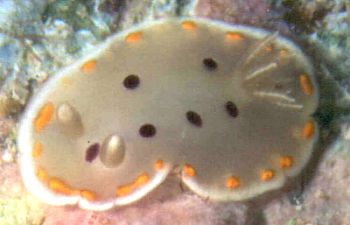
Dear Bill
One of the specimens found by Dean Lea in July 1999 at a depth of 5ft in a muddy channel with a fast moving current is this Dorid (OWN149 OS00564) which we could not identify on site in the Tukang Besi, SE Sulawesi Operation Wallacea. In reading through literature since then, and more recently, I think it is closest to Chromodoris tumulifera (Collingwood 1881) although at one point I thought it could be Chromodoris kitae (Gosliner 1994). The external features and colouration should be quite clear from the attached jpeg with the addition of the following: opaque off white foot. The purple spots on the notum are raised (one just in front of the rhinophores, three down either side with the last on the right side partly obscured by the branchial plume). The rhinophores are retractile, lamellate with white tip, white base and pale beige lamellae. The branchial plume consists of five segments, all pale beige with a bright white line along the outer edge and decreasing in length towards the rear and lying inclined to the rear rather than upright.
Which of these possible identifications, if either, would you think could be right?
Many thanks and all the best as ever
Lindsay
alldcl@compuserve.com
Warren, L., 2001 (Jun 3) Chromodoris tumulifera from Sulawesi. [Message in] Sea Slug Forum. Australian Museum, Sydney. Available from http://www.seaslugforum.net/find/4448Dear Lindsay,
I think this is a colour form of C. tumulifera. As I discuss at the top of the page I originally considered C. tumulifera and C. bimaensis to be distinct species but having seen specimens from throughout the Indo-West Pacific I am now sure they are the same. I have seenthis colour form in Hong Kong and New Caledonia and will try an post some photos showing the variation in the near future.
Gosliner (1994) considered C.kitae, from northern Madagascar to be distinct, mainly because the orange submarginal line was interrupted by both white and red-purple spots, while in C. tumulifera it is only interrupted by purple spots. I suspect the differences fall within the range of variation of C. tumulifera.
• Gosliner, T.M. (1994) New species of Chromodoris and Noumea (Nudibranchia: Chromodorididae) from the western Indian Ocean and southern Africa. Proceedings of the California Academy of Sciences 48(12): 239-252. (8 figs)
Best wishes,
Bill Rudman.
Chromodoris tumulifera
May 21, 1999
From: Bill Rudman
I have added a page on Chromodoris tumulifera as it helps illustrate my answer to Austin's question on mantle glands in chromodorids.
Bill Rudman.
